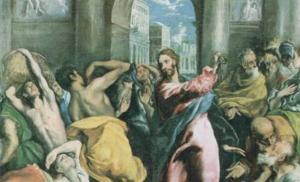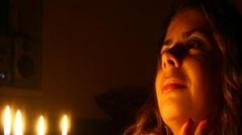How Jesus drove the merchants out of the temple. Bible online
How can you comment on the words of Fr. Andrei Kuraev about Christ’s expulsion of merchants from the temple, i.e. Still, why were they kicked out? "the exchanger in the temple was a) necessary; b) he was the product of religious logic, and not self-interest. And therefore this act of Christ was all the more unexpected. And it was all the more strange because the enemies of Christ were, rather, the non-trading priests of that temple ( it is they who will soon pass judgment on Him) than the money changers. But He does not drive out the priests, but these merchants. In general, the actions and decisions of Christ are very unpredictable.” Svetlana.
Priest Antony Skrynnikov answers:
Hello, Svetlana!
There are several points of view why Christ did this. I stick to the following. As you know, traditional Israeli society was divided into four groups: Pharisees, Sadducees, Essenes and Zealots. The latter were a closed society of terrorists who regularly rebelled against Roman authority. Their last uprising ended very sadly. The Roman Emperor Titus besieged Jerusalem and completely destroyed it.
To engage in subversive activities, both then and now, material resources are needed. And the Zealots earned money for their activities by selling sacrificial animals in the Jerusalem Temple. That is why the Lord says that His house became a den of thieves. When He drove out the merchants, He drove out the robbers, not the sellers.
You can get acquainted with other points of view.
Sincerely, priest Anthony Skrynnikov.
Read also
(Cleansing the Temple)
(Matthew, 21:12-13; Mark, 11:15-19;
Luke 19:45-46; John 2:13-17)
(13) The Passover of the Jews was approaching, and Jesus came to Jerusalem (14) and I found that oxen, sheep and doves were being sold in the temple, and money changers were sitting.(15) And making a scourge of ropes, he drove everyone out of the temple, also the sheep and oxen; and he scattered the money from the money changers and overturned their tables. (16) And he said to those who sell doves: take this from here, and do not do it at my Father's househouse of trade. (17) At this His disciples remembered that it was written: Jealousy through Your house it devours Me.
(John 2:13-17)
All four evangelists give a story about the cleansing of the temple from those who traded in it. However, according to the Synoptics, this action of Christ is one of His last acts, while according to John it is the beginning of His public ministry. The different location of this event in the life of Christ and some differences in the story of the weather forecasters, on the one hand, and John, on the other, gave reason to believe that Jesus attempted to cleanse the temple twice. The first cleansing came as a complete surprise to the people, but the second, which occurred about three years later, became one of the immediate causes of His death (“The scribes and high priests heard this, and sought how to destroy Him” - Mark 11:18). The special significance of this plot is that Jesus here for the first time publicly proclaimed himself the Son of God, calling God his Father.
It was necessary to sell sacrificial animals mainly for foreigners who came to Jerusalem from afar and could not bring them with them. Even Moses foresaw such a need (Num. 15:13-15). Strictly speaking, money changers were also necessary, since foreign coins were not accepted either into the treasury or to pay the taxes collected on the temple (cf. THE MIRACLE WITH THE STATIRE; but not with DENARIUS OF CAESAR- here there is a different tax and a different currency); Foreigners arriving in Jerusalem had little Jewish money, since it was not in circulation in other places, and the temple tax had to be paid in sacred shekels (shekels). In a word, there were a great many money changers and merchants in Solomon’s porch (according to Josephus, on one of the Passovers he described, 256,500 lambs were sold).
Monuments of fine art cannot answer the question whether the artist meant that there was one purification, or whether he believed that there were two. However, certain details that the artists depict shed light on which of the stories - the weather forecasters or John - the given master illustrates. Thus, only John mentions the “scourge of ropes” ( Giotto, El Greco).
Giotto. Expulsion of traders from the temple (1304-1306). Padua. Scrovegni Chapel.
El Greco. Cleansing of the Temple (c. 1600). London. National Gallery.

Artists were attracted by the opportunity to convey the dynamism of what was happening: running animals, traders defending themselves and dodging blows, overturned tables... Some artists focused on the expulsion of traders of sacred animals (Giotto, El Greco), others - on the money changers ( Rembrandt).
Rembrandt. Expulsion of traders from the temple (1626). Moscow. Pushkin Museum im. A. S. Pushkina

Interesting thoughts about Rembrandt’s painting are given by M. S. Senenko: “When creating the composition, the artist was guided by the engraving A. Durer from the “Lesser Passions” series, in particular, the setting of the figure of Christ.<…>
Albrecht Durer. Expulsion of traders from the temple.
(From the series of engravings “Little Passions”). (c. 1509).

The money changer looking back at Christ is one of the constant characters, the so-called “Rembrandt’s father”, depicted in many paintings of the Leiden period" ( Rembrandt, his predecessors and followers. M. 2006. P. 48)
In addition to those who were expelled, the disciples of Christ could also be depicted (the basis for this: John 2:17) (Valentin) and the scribes with the high priests (Mark 11:18). In accordance with the symbolism of space to the left and right hand of Christ (for more details, see CRUCIFIXION OF CHRIST; THE LAST JUDGMENT) the first were placed on the “good” side (on the right hand), the second - on the “bad” side on the left ( Giotto). To depict blind people who have received their sight in this scene ( El Greco) the basis is found in Matthew: “And the blind and the lame came to Him in the temple, and He healed them” (Matthew 21:14).
Christ's expulsion of the merchants from the temple typologically implies the Old Testament expulsions, which the old masters included, according to the medieval Christian concept, in this scene. Thus, El Greco, in particular, depicts the plot of the Expulsion of Adam and Eve from Paradise as one of the bas-reliefs of the temple. Another exile, which was also considered a prototype of the Cleansing of the Temple, was the Expulsion of Heliodorus (Heliodorus, one of the dignitaries of the court of Seleucus Philopator, was sent to Jerusalem to plunder the temple of Solomon; having come to the temple for this purpose, he was expelled from it by a “terrible horseman” on horseback : “Running quickly, he struck Heliodorus with his front hooves, and he who sat on him seemed to have a golden armor” - 2 Mac 3:25).
Another parallel to the Cleansing of the Temple was drawn by Renaissance humanists. They saw a pagan prototype of it in the fifth labor of Hercules - the cleansing of the Augean stables. During the Reformation, the cleansing of the temple by Jesus Christ was seen as an allusion to Luther’s condemnation of the practice of selling papal indulgences ( Rembrandt; the emphasis on expulsion from the temple changed).
EXAMPLES AND ILLUSTRATIONS:
First Easter
Expulsion of traders from the Temple
(John 2:13-25)
The first three Evangelists do not tell us very clearly about the Lord’s stay in Jerusalem; they tell in detail only about the Passover before which He suffered. Only St. John tells us in sufficient detail about each visit of the Lord to Jerusalem on Easter during all three years of His public ministry, as well as about His visits to Jerusalem on some other holidays. It was quite natural for the Lord to appear in Jerusalem on all major holidays, since the spiritual life of the entire Jewish people was concentrated there; on these days people from all over Palestine, as well as from other countries, gathered there, and it was there that it was important for the Lord to reveal Himself as Messiah.
The expulsion of the merchants from the temple described at the beginning of the Gospel of John differs from a similar event described by the first three Evangelists. The first exile occurred at the beginning of the Lord's public ministry, and the last (since, in fact, there could be several of them) at the very end of His public ministry, before the fourth Passover.
From Capernaum, as can be seen further, the Lord, accompanied by His disciples, went to Jerusalem, but not simply out of duty before the law, but to do the will of Him who sent Him, in order to continue the work of the Messianic ministry begun in Galilee. At the Passover holiday, up to two million Jews gathered in Jerusalem, who were obliged to slaughter the Passover lambs and bring sacrifices to God in the temple. According to Josephus, in the year 63 AD, on the day of the Jewish Passover, 256,500 Passover lambs were slaughtered by the priests, not counting small livestock and birds. In order to make it as convenient as possible for the sale of all this multitude of animals, the Jews turned the so-called “yard of the pagans” into a market square: they herded sacrificial cattle there, placed cages with birds, set up shops for selling everything necessary for sacrifices, and opened changing offices. Roman coins were in circulation at that time, and the law required that taxes to the temple be paid in Jewish cycles. Jews who came for Passover had to change their money, and this exchange brought great income to the money changers. In an effort to make money, the Jews traded in the temple courtyard with other items that had nothing to do with the sacrifice, such as oxen. The high priests themselves were engaged in breeding pigeons to sell them at high prices.
The Lord, having made a scourge from ropes that were probably used to tie animals, drove the sheep and oxen out of the temple, scattered the money of the money changers, overturned their tables, and, approaching the pigeon sellers, said: “Take this from here, and do not make My Father’s house a house of trade.”. Thus, by calling God His Father, Jesus for the first time publicly declared Himself to be the Son of God. No one dared to resist the Divine authority with which He did this, since, obviously, John’s testimony about Him as the Messiah had already reached Jerusalem, and, apparently, the conscience of the sellers began to speak. Only when He reached the doves, thereby affecting the interests of the high priests themselves, did they notice to Him: “By what sign will You prove to us that You have the authority to do this?” To this the Lord replied: “Destroy this temple, and in three days I will raise it up”. Moreover, as the Evangelist further explains, Christ meant "temple of His Body", that is, by this He wanted to say to the Jews: You ask for a sign, it will be given to you, but not now: when you destroy the temple of My Body, I will erect it in three days, and this will serve you as a sign of the power with which I do this.
The chief priests did not understand that with these words Jesus predicted His death, the destruction of His body and His resurrection from the dead on the third day. They took His words literally, referring them to the Jerusalem temple, and tried to stir up the people against Him.
Meanwhile, the Greek verb “egero”, translated by the Slavic “I will erect”, means actually “I will awaken”, and this verb cannot in any way be attributed to the destruction of a building; it is much more suitable for the concept of a body immersed in sleep. Naturally, the Lord spoke of His Body as a temple, for it contained His Divinity; and being in the temple-building, it was especially natural for the Lord Jesus Christ to speak of His Body as a temple. And every time the Pharisees demanded some sign from the Lord, He answered that there would be no other sign for them except what He called the sign of the prophet Jonah - the uprising after a three-day burial. In view of this, the words of the Lord addressed to the Jews can be understood as follows: is it not enough for you to desecrate the hand-made house of My Father, making it a house of trade? Your malice leads you to crucify and put to death My body; do this, and then you will see such a sign that will strike with horror all my enemies: I will raise up my mortified and buried body in three days.
The Jews, however, seized on the external meaning of Christ's words and tried to make them absurd and impracticable. They pointed out that this temple, the pride of the Jews, took 46 years to build, and how can it be restored in three days? We are talking here about the resumption of the construction of the temple by Herod. Construction of the temple began in the 734th year from the founding of Rome, that is, 15 years before the birth of Christ, and the 46th year falls on the 780th year from Fr. R., that is, for the year of the first Evangelical Easter. Even the Lord’s disciples themselves understood the meaning of His words only when the Lord rose from the dead and “I opened their minds to understand the Scripture”.
Further, the Evangelist says that during the Easter holiday, the Lord performed miracles, seeing which, many believed in Him, but “Jesus Himself did not entrust Himself to them”, that is, he did not rely on them, on their faith, since faith based on miracles alone, not warmed by love for Christ, cannot be considered strong. The Lord “knew everyone” as an omnipotent God, “knew what was in man” - what was hidden in the depths of everyone’s soul, and therefore did not trust the words of those who, seeing His miracle, confessed their faith to Him.
(Matthew, 21:12-13; Mark, 11:15-19; Luke 19:45-46; John 2:13-17)
(13) The Passover of the Jews was approaching, and Jesus came to Jerusalem (14) and I found that oxen, sheep and doves were being sold in the temple, and money changers were sitting.(15) And making a scourge of ropes, he drove everyone out of the temple, also the sheep and oxen; and he scattered the money from the money changers and overturned their tables. (16) And he said to those who sell doves: take this from here, and do not do it at my Father's househouse of trade. (17) At this His disciples remembered that it was written: Jealousy through Your house it devours Me. (John 2:13-17)
All four evangelists give a story about the cleansing of the temple from those who traded in it. However, according to the Synoptics, this action of Christ is one of His last acts, while according to John it is the beginning of His public ministry. The different location of this event in the life of Christ and some differences in the story of the weather forecasters, on the one hand, and John, on the other, gave reason to believe that Jesus attempted to cleanse the temple twice. The first cleansing came as a complete surprise to the people, but the second, which occurred about three years later, became one of the immediate causes of His death (“The scribes and high priests heard this, and sought how to destroy Him” - Mark 11:18). The special significance of this plot is that Jesus here for the first time publicly proclaimed himself the Son of God, calling God his Father.
It was necessary to sell sacrificial animals mainly for foreigners who came to Jerusalem from afar and could not bring them with them. Even Moses foresaw such a need (Num. 15:13-15). Strictly speaking, money changers were also necessary, since foreign coins were not accepted either into the treasury or to pay the taxes collected on the temple.Foreigners arriving in Jerusalem had little Jewish money, since it was not in circulation in other places, and the temple tax had to be paid in sacred shekels (shekels). In a word, there were a great many money changers and merchants in Solomon’s porch (according to Josephus, on one of the Passovers he described, 256,500 lambs were sold).
Monuments of fine art cannot answer the question whether the artist meant that there was one purification, or whether he believed that there were two. However, certain details that the artists depict shed light on which of the stories a given master illustrates. So, only John mentions the “scourge of ropes”.
Giotto. Expulsion of traders from the temple (1304-1306). Padua. Scrovegni Chapel.
El Greco. Cleansing of the Temple (c. 1600). London. National Gallery.

Artists were attracted by the opportunity to convey the dynamism of what was happening: running animals, traders defending themselves and dodging blows, overturned tables... Some artists focused on the expulsion of traders of sacred animals, others - on money changers .
Rembrandt. Expulsion of traders from the temple (1626).

M. S. Senenko gives interesting considerations about Rembrandt’s painting: “When creating the composition, the artist was guided by Durer’s engraving from the “Lesser Passion” series, in particular, the setting of the figure of Christ.
Albrecht Durer. Expulsion of traders from the temple.
(From the series of engravings “Small Passions”). (c. 1509)

The money changer looking back at Christ is one of the constant characters, the so-called “Rembrandt’s father”, depicted in many paintings of the Leiden period" ( Rembrandt, his predecessors and followers. M. 2006. P. 48)
In addition to those who were expelled, the disciples of Christ could also be depicted (the basis for this: John 2:17) (Valentin) and the scribes with the high priests (Mark 11:18). In accordance with the symbolism of space to the left and right hand of Christthe first were placed on the “good” side (on the right hand), the second on the “bad” side on the left. Matthew has a basis for depicting blind people who have received their sight in this scene: “And the blind and lame came to Him in the temple, and He healed them” (Matthew 21:14).
Christ's expulsion of the merchants from the temple typologically implies the Old Testament expulsions, which the old masters included, according to the medieval Christian concept, in this scene. Thus, El Greco, in particular, depicts the plot of the Expulsion of Adam and Eve from Paradise as one of the bas-reliefs of the temple. Another exile, which was also considered a prototype of the Cleansing of the Temple, was the Expulsion of Heliodorus (Heliodorus, one of the dignitaries of the court of Seleucus Philopator, was sent to Jerusalem to plunder the temple of Solomon; having appeared for this purpose in the temple, he was expelled from it by a “terrible horseman” on a horse: “Running quickly, he struck Heliodorus with his front hooves, and he who sat on him seemed to have a golden armor” - 2 Mac 3:25).
Another parallel to the Cleansing of the Temple was drawn by Renaissance humanists. They saw a pagan prototype of it in the fifth labor of Hercules - the cleansing of the Augean stables. During the Reformation, the cleansing of the temple by Jesus Christ was seen as an allusion to Luther’s condemnation of the practice of selling papal indulgences

Ghiberti. expulsion of traders from the temple
Alexander MAYKAPAR













